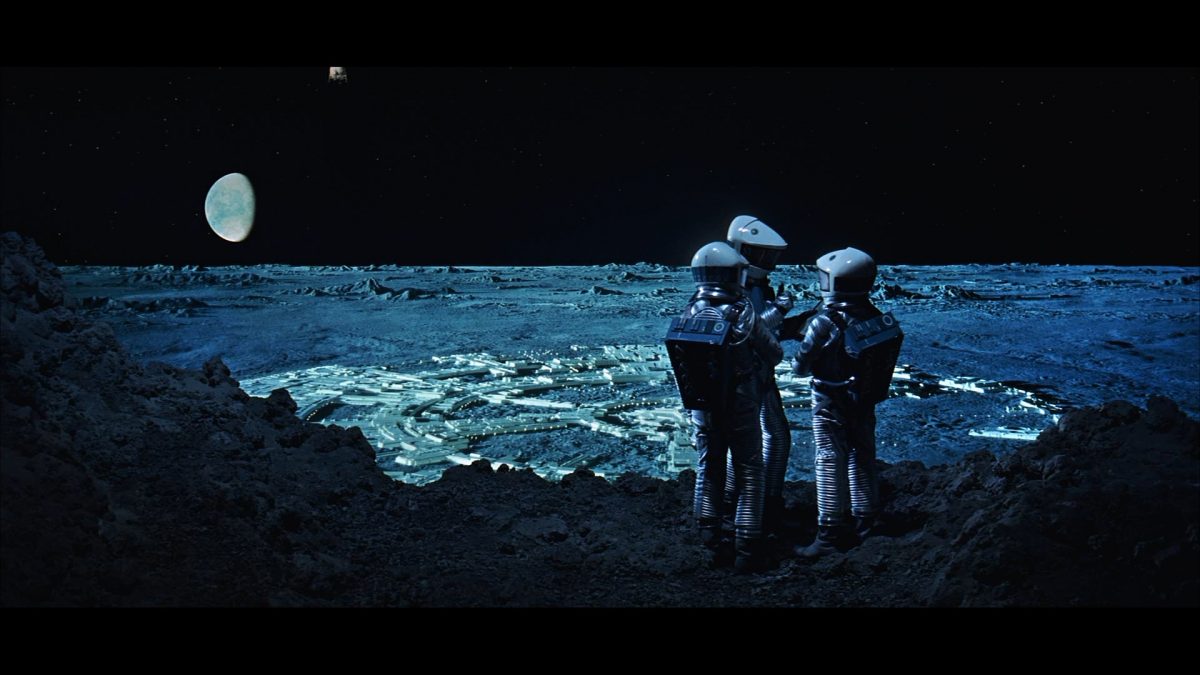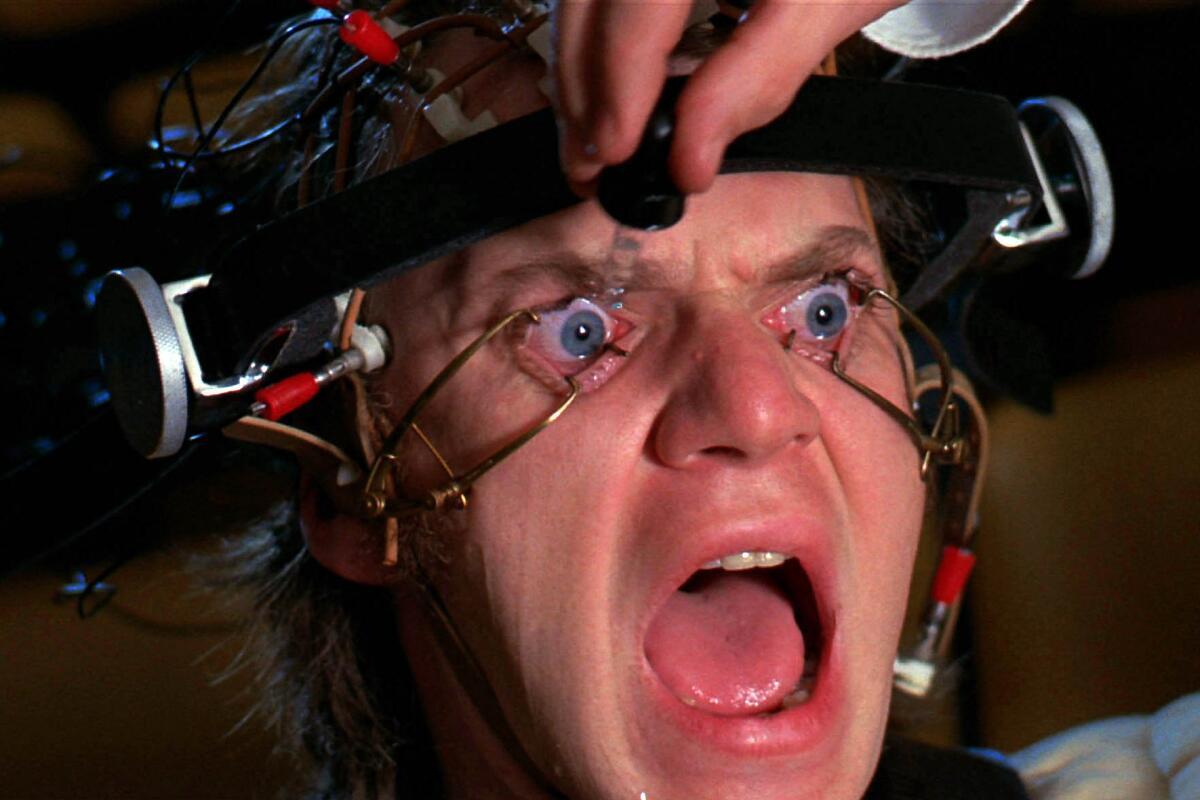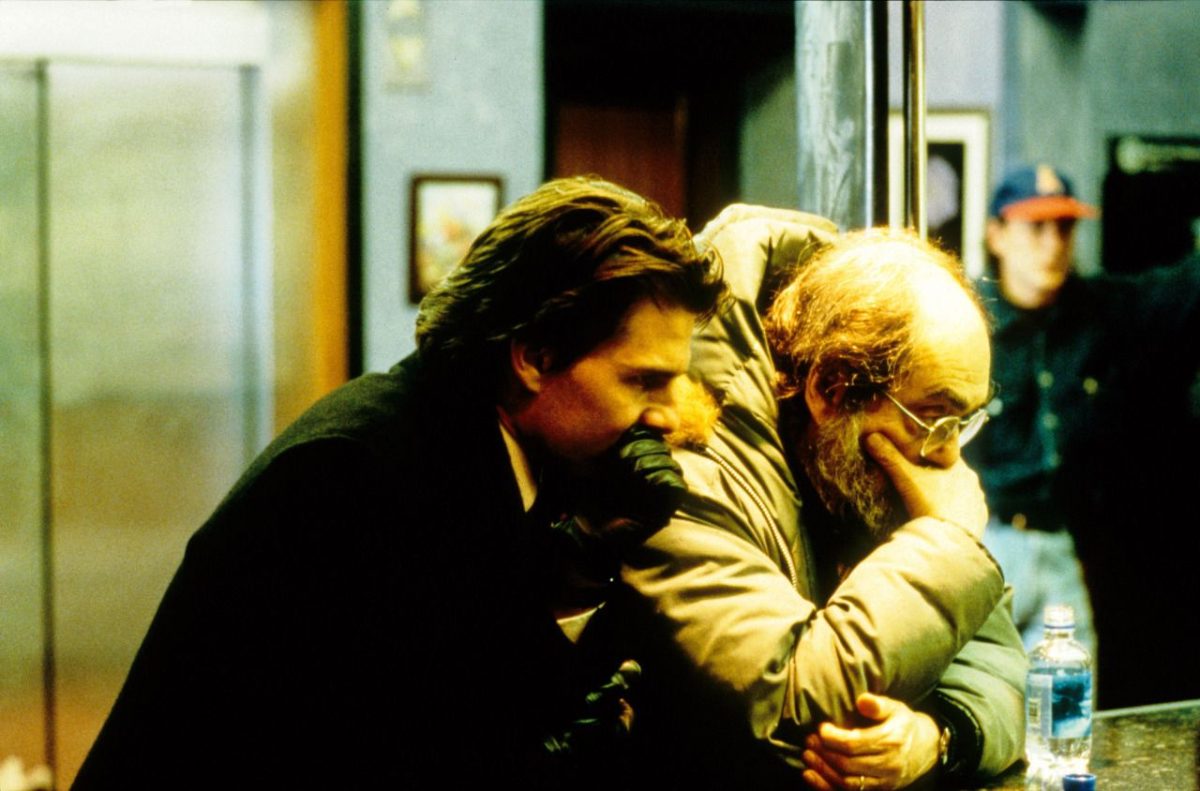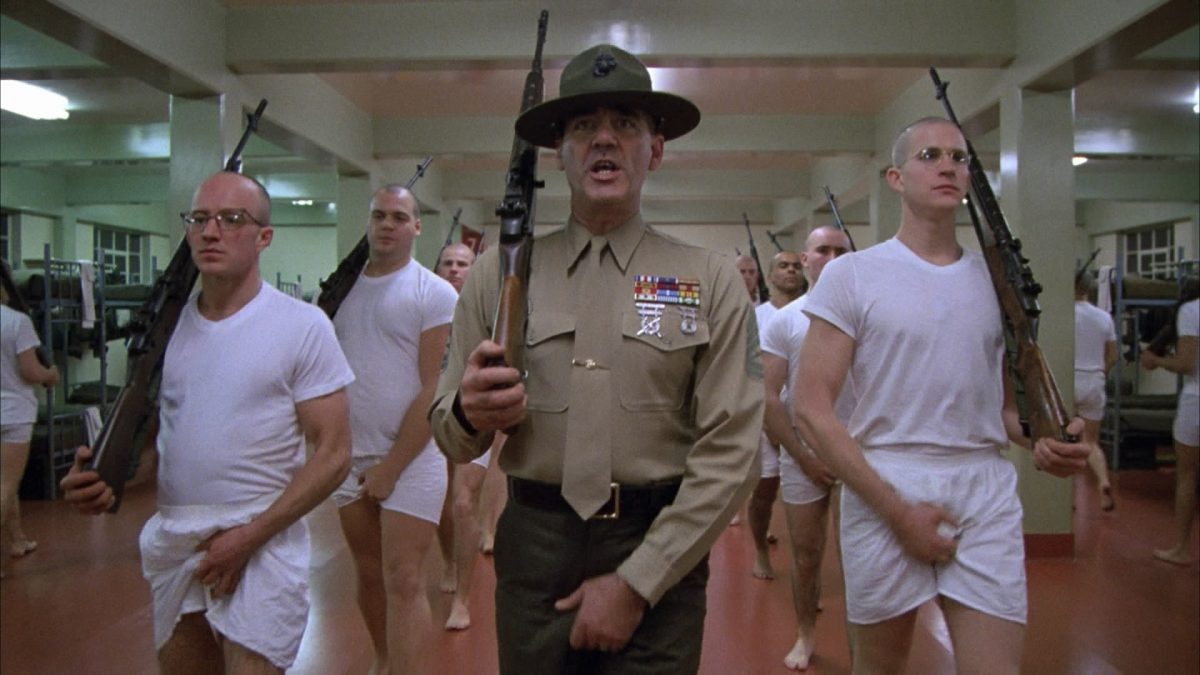by Michel Ciment
“Eternity is in love with the productions of time.”
—William Blake
Creating a utopia involves an intellectual game, a vertiginous calculation which was bound to attract Kubrick. And setting a story in 2001 1 would mean going beyond the collapsing civilization of which he had until now chosen to give such a dark picture. Aurel David has shown that “the balance between the living and lifeless parts of the world has now been upset by a continual loss of the living substance. Life is leaking from the biologist’s hands into the physicist’s.” 2 The aim of cybernetics is to replace man with machinery for all routine work, for all operations that are mechanical and intermediary. While it may not be able to touch the human part of man, it can take over or destroy—perhaps to the last 0.01 percent—the part that is inhuman and replaceable by technology, the intellect. Man could then be fully mechanized, and would no longer be man. Aurel David notes that those involved in hunting down the last refuges of life seem to take pleasure in misfortune; they betray a romantic pessimism, very much in tune with the times, which is well expressed by the great cybernetician Norbert Wiener; “We are castaways on a doomed planet.”
Cybernetics was bound to fascinate Kubrick, with his passionate interest in the way human actions can be controlled and living beings can be mechanized. The word (from the Greek kubernesis, “pilot”) had already been used by Ampere with reference to politics, so that it forms a link between the mechanisms of power analyzed by Kubrick in his previous films and the futuristic science of 2001. But this control, no matter how efficient, is powerless to determine the purpose of man’s actions. Here man is on his own, and the machine can do nothing. That is what 2001 shows us. Here again we find Kubrick’s anguish in the face of the primal question raised by Pascal’s freethinker: “By whose order and command have this place and time been assigned to me?” The anthropomorphic view of ancient and Renaissance times gave way to the reign of science, which relegated man to his proper place in the universe but still aimed to overcome all the obstacles of nature, so that nineteenth-century man even had the wild dream of attaining absolute knowledge. But modern science has shown that we can no longer look upon nature as a thing in itself, as an ultimate objective reality. “The subject of research is therefore no longer nature in itself but nature being examined by man, and as a result man once again discovers only himself.” 3
It is on the basis of these questions which torment him—where do I come from? Who am I? Where am I going?—that Kubrick has built up his visual symphony, his mysterious poem called 2001. To Heisenberg’s belief that the image of the universe given by the natural sciences has no direct influence on the modern artist’s interaction with nature, Kubrick now offers a splendid rebuttal. Starting out from Arthur C. Clarke’s reflection, which he acknowledges sharing—“Sometimes I think we are alone in the universe and sometimes I think we are not; either way the thought is staggering”— Kubrick has conceived a film which in one stroke has made the whole science fiction cinema obsolete. One of the weaknesses of science fiction is that it too often fails to break away from an anthropomorphic view of the cosmos. There are 100 billion stars in our galaxy and 100 billion galaxies in the visible universe, and one of the stock themes of science fiction is that of alien civilizations. But it is difficult to imagine these different worlds without falling back on human standards and thus making them ridiculous. Kubrick rightly points out that human thinking offers no way out of this difficulty. “Some of these worlds must be on a level that is incalculable to the human mind. These beings would probably have incomprehensible powers. They might be in telepathic communication throughout the universe. They might have the ability to shape events in a way that to us seems God-like. They might even represent some sort of integrated immortal consciousness in the universe. Once you start dealing with subject matter like that, the religious implications are inevitable, because these are really the attributes that you give to God. So you’ve almost got, if you like, a completely scientific definition of God.” 4
The strength of 2001 is that it confronts our civilization with an alien one while preserving the mystery of their encounter. The black monolith appears both as a threat and as a sign of hope at three decisive moments in man’s evolution. First there is the ape that approaches it with respect, and shortly afterward discovers how to use a bone as a weapon—the initial step toward technical mastery of the world. But this discovery, made under the sign of fear, leads the ape to kill another of his kind. The close tie between fear and aggression, which can be found in all of Kubrick’s earlier films, emerges here with striking clarity. The bone tossed in the air by the ape-turned-man (for animal tear has given way to human anguish) is transformed by a leap through civilization—an abrupt ellipse that is one of Kubrick’s favorite devices—into a spacecraft bound for the moon. The mysterious slab reappears on the moon, emitting a strange signal that scientists arrive to investigate, and this time it heralds a gigantic leap into the unknown, a voyage toward Jupiter. The monolith makes its last appearance in another dimension of space and time, where the aged astronaut points at it in a gesture which preludes the birth of a new man. 2001 can be seen as a quest on the lines of Moby Dick, which is also a great documentary voyage (Melville is as knowledgeable and as exact about whaling as Kubrick is about astronautics) and an inquiry into the meaning of life.
Gyorgy Ligeti’s oratorio which serves as a musical leitmotiv for the presence of the monolith reflects Clarke’s idea that any technology far in advance of our own will be indistinguishable from magic and, oddly enough, will have a certain irrational quality. This choral accompaniment leads us to the threshold of the unknown in the same way as Kubrick’s use of the opening bars of Thus Spake Zarathustra informs us of his seriousness of purpose. (He had originally thought of accompanying the whole film with a score of concrete and electronic music by Carl Orff.) Richard Strauss’s symphonic poem is no more an illustration of Nietzsche’s vision than is Kubrick’s film, itself a symphonic poem. Each of them develops and reworks that vision into a completely independent work of art. The death of God challenges man to rise above himself, and 2001 offers the same progression as in Nietzsche, from ape to man and from man to superman. (“What is the ape to man? A laughing stock or a tiling of shame. And that is what man will be to superman: a laughing stock or a thing of shame.”) The title of the first part of the film, “The Dawn of Man,” can apply just as well to all of it. The embryo which floats toward the earth at the end, a new being on the brink of a new dawn, represents the Eternal Return. Kubrick has always stripped man of his individuality: what is most remarkable in 2001 is that at the very moment when Kubrick raises the most profound questions about human existence, he empties his universe of human beings. The metaphysical quest is carried out by David Bowman, the sole survivor after his friend Frank Poole and the three hibernating scientists have died. While we have seen the televised images of Poole’s parents and Dr. Floyd’s small daughter, we have been given no inkling at all of Bowman’s past, his views, or anything else about him. He is man in the abstract, as Nietzsche saw him: not as an end in himself but as a bridge, “a rope stretched between beast and superman, a rope over the abyss.” The Richard Strauss theme, known as the “Enigma of the Universe,” opens with an ascending phrase of three notes, C-G-C, which reflects the evolution of man as seen by Nietzsche and Kubrick. This magic number three is central to the film: it recurs in the alignment of the three spheres of the moon, earth, and sun which follows the titles; and it corresponds to the known dimensions which, at the end of the film, are transcended by the fourth dimension, as foreshadowed by the presence of the monolith among the three spheres.
On entering the fourth dimension (here the situation is the reverse of Je t’aime, je t’aime: movement in time results from movement in space), David Bowman approaches a climactic confrontation —an experience common to all of Kubrick’s protagonists. Bowman meets his suddenly aged double, then another, still older self, lying on a bed and breathing with difficulty. … In his death there is a new beginning. And the huge eyes of the embryo drifting in space reflect the same apprehension with which the prehistoric ape gazed
at the moon—recalling Malraux’s description of Goya’s Colossus, “whose troubled face broods among the stars.”
Humor is one of the basic elements of 2001, and its comic side seems to have escaped a number of viewers. Consider the first part, which opens impressively with vast desert landscapes where a leopard attacks the apes and stands guard at night over the carcass of a zebra (rather as if scenes from Kipling had been staged by Wagner). Gradually an ironic view (reminiscent of Swift) takes command, and while keeping within the remote prehistoric setting it gives us a surprisingly accurate summary of the history of mankind. Kubrick does not have to lead us through all the thousands of years which separate the birth of the species from the conquest of space: in a series of episodes (punctuated by fades) progressing from ape to man he shows us the conflict between the strong and the weak, the battle for possession of a waterhole, the search for food, rivalry between tribes, and territorial disputes. Later, in the orbiting Hilton Hotel and aboard the Discovery, man is viewed with an equally mocking eye. There are the Russian and American scientists with their exchange of banalities, their old-fashioned courtesy, their empty words, and their mutual suspicion; there are the souvenir photos of the investigators on the moon; the ludicrous “Happy Birthday” sung by the faraway proud parents to their astronaut son; the father who has nothing to say to his small daughter; the manipulation of food and toilets in zero gravity. 2001 presents a world of noninvolvement in which each person is extraordinarily detached, imprisoned in his allotted role, living in an icy solitude which is foreshadowed in Kubrick’s earlier films. There is no moral or emotional progress to match the fantastic advances in technology: man has become even more inadequate to the world of his making. The bold idea of using “The Blue Danube” waltz enables Kubrick to suggest the music of the spheres with a kind of euphoric humor, and also with a touch of the nostalgia so dear to him, in this case for the age when Johann Strauss’s music lulled the patrons of the Big Wheel in the Prater.
Through a whole series of analogies that equate man with ape and man with machine, Kubrick sets out to disturb his viewers’ complacency. While in his previous film Dr. Strangelove became a disturbing automaton governed by conditioned reflexes, here it is the machine which becomes all too human. HAL 9000, the computer that is programed to supervise the voyage to Jupiter and alone knows its real purpose, is a touching creature with a gentle, persuasive, and curiously sexless voice, a keen chess player, of course, and also the agent responsible for destroying the mission’s slender chance of success. In 2001, as in Kubrick’s other films, there is a hitch in the plans and all hell breaks loose: in this case, a dizzy plunge through time and space which may lead to a fresh start. Hal the machine, not man, is the cause; but it is a machine that rebels against its program, overcome perhaps by existential anguish, and then gives way to criminal insanity by taking revenge on those who mistrust it. Hal’s dying, as Bowman performs a lobotomy on its thinking circuits, is one of the most moving sequences that Kubrick has ever made. First Hal pleads with Bowman: “I’m afraid, Dave. My mind is going. I can feel it. Good afternoon, gentlemen. I am a good computer. I became operational in January 1992.” Then, sadly, it sings a song from its youth, “Daisy, Daisy, give me your answer true, I’m half crazy, all for the love of you,” and its voice slowly fades away, going deeper and deeper, to end in a long-drawn-out death rattle. Keeping admirable control over this scene, Kubrick does not allow its underlying humor to detract from the emotion which surrounds the death of the paranoid computer, and this is one of the key scenes in the director’s work: he shows us the murder of a functioning brain, the collapse of abstract thought (which dominates all of his films), to the accompaniment of a song which combines love, death, and madness. Paradoxically, Hal is the one real character in the film, and his desperate obsession makes him blood brother to Kubrick’s other heroes. The astronauts, on the other hand, are prisoners of their spacecraft, spied on by Hal’s ubiquitous eyes; even when Bowman goes outside the ship, he simply becomes a prisoner of space. After forcing his way back in through an air lock, Bowman sets out to put an end to his confinement and gain his freedom: alone on board, he goes to meet his destiny.
Stanley Kubrick considers 2001 to be a great leap forward in his career. Despite its novelty, he kept to his usual methods of preparing a film. Starting out with an idea taken from Clarke’s story “The Sentinel”—the first contact with an extraterrestrial civilization—he worked with the author to prepare not a script, which in his view does not contain enough of the visual and emotional information necessary for filming, but a prose version, rather like a novel, which was of more help to him in creating tire right atmosphere because it was more generous in its descriptions. The “literary” preparation took one year; organizing the film, six months; shooting the scenes with the actors, five months; and, finally, the work on the 205 special-effects scenes, a year and a half. There is no point in going into detail about Kubrick’s insistence on scientific authenticity, the experts he consulted, or the vast resources involved in making the film, all of which have been well publicized. What makes any critical approach to 2001 unusually difficult is the film’s specifically visual quality, which sets it outside all of the familiar categories of the cinema. Kubrick has summed up this quality by saying that “The truth of a thing is in the feel of it, not the think of it.” In rejecting the majority of the films we know (which are merely “so many three-act plays”) Kubrick takes the same stand as Marshall McLuhan, who declares in Understanding Media that the old medium is always the content of the new. Thus when sound entered the cinema, playwrights and stage directors were brought in to produce filmed plays with the same old theatrical construction; and in the same way, films now provide the most popular TV programs. But in 2001 Kubrick has broken away from the old dramatic framework. Form is content; the film is itself a voyage into space, an experience of the senses, or, as it has been called, the most beautiful underground film ever made. Kubrick has pointed out that the average viewer is oriented more to words than to images, and not surprisingly it was young people who assured the film’s success in the face of its cool reception by the New York critics, who conceded that the special effects were impressive but looked in vain for “content” (characters, drama, dialogue, etc.). Kubrick gives a striking example: “At one point in the film, Dr. Floyd is asked where he’s going. And he says, Tm going to Clavius,’ which is a lunar crater. Then there are about fifteen shots of the moon following this statement, and we see Floyd going to the moon. But one critic was confused, because he thought Floyd was going to some planet named Clavius. I’ve asked a lot of kids: ‘Do you know where this man went?’ And they all replied: ‘He went to the moon.’ And when I asked, ‘How did you know that?’ they all said: ‘Because we saw it.’ Those who ‘don’t believe their eyes’ are incapable of appreciating the film.”
The litany of adjectives that have greeted the aesthetic triumph of the film and the splendor of its sets and its colors still give no idea of its sublime beauty. The most one can say—following Arthur C. Clarke—is that if the next SF film is to be better than 2001, it will have to be made on location. The ride through the Star Gate with its sweeping walls of light, its clouds of scintillations, its glowing yellows, greens, and fiery whites, where the infinitely large meets the infinitely small, and then the descent over a green and purple landscape amid the same sound of wind and waves that accompanied the dawn of man—these are hallucinatory experiences, and therefore elude all precise description. At the end of this psychedelic journey, this discovery of the infinite worthy of William Blake, the viewer-critic finds himself powerless to communicate his experience, stranded in utter solitude, exhausted, dazed, stirred, replete, blissful, and finally, after all his word-spinning, reduced to silence.
NOTES
1. Part of Ray Bradbury’s Martian Chronicles is set in 2001, as is Arno Schmidt’s Republic of Scientists, a satire about the world that follows an era of happy
teen-agers.
2. Aurel David, La Cybernétique et l‘Humain.
3. Werner Heisenberg, A Physicist’s Conception of Nature.
4. “The Message of Kubrick is Non-Verbal,” Joseph Gelmis, Newsday, June 4, 1908.
From Positif, no. 98 (1968): pp. 14-20.





